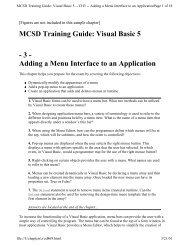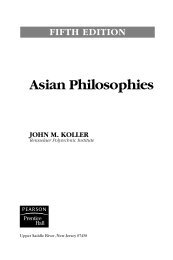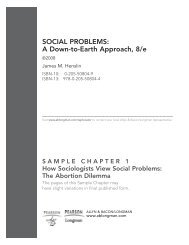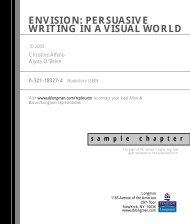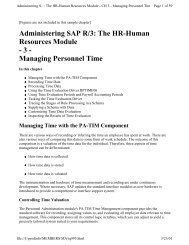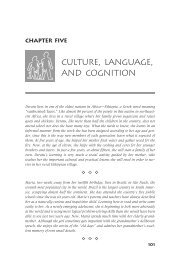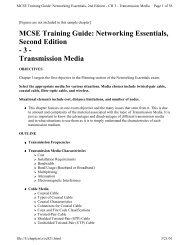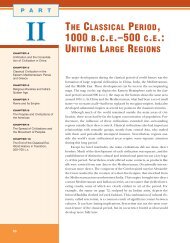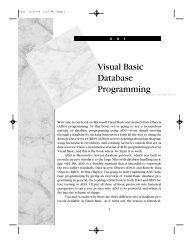Phonetic Transcription and Diacritics
Phonetic Transcription and Diacritics
Phonetic Transcription and Diacritics
Create successful ePaper yourself
Turn your PDF publications into a flip-book with our unique Google optimized e-Paper software.
48 CHAPTER 3<br />
Think of the symbol as a pointer with its base<br />
the top of the T-type notation. If the pointer<br />
projects down [�], the tongue has been lowered;<br />
if it points up [�], the tongue has been raised.<br />
a lowered [i] ([i�]) signify the same vowel quality?<br />
The answer is no. Therefore, in our previous<br />
example, one has to make a decision as to<br />
whether this vowel realization sounded more<br />
like an [e]- or an [i]-type vowel. Based on the<br />
transcriber’s auditory perception, the basic<br />
vowel quality must fi rst be chosen, <strong>and</strong> then<br />
the modifying diacritic mark should be added<br />
to it.<br />
Advanced/Retracted Tongue Position. There<br />
are also diacritics signaling tongue variations<br />
on the horizontal plane that lead to deviations<br />
from norm productions. They indicate a<br />
tongue position that is too far forward or too<br />
far back for a norm production of the vowel<br />
in question. The diacritic for vowels produced<br />
with a tongue elevation more advanced than<br />
usual is [ � ]. More retracted protrusions are<br />
marked by the diacritic [ � ]. Both are placed under<br />
the vowel symbol: [ε�] , for example.<br />
CLINICAL COMMENTS<br />
Changes in the position of the tongue for vowel realizations<br />
are often perceptually diffi cult to target. Although<br />
transcribers are aware that the vowel quality is<br />
“off,” they may not be sure in which direction. If the<br />
tongue has been lowered or raised, the vowel quality<br />
will sound somehow similar to the neighboring vowel<br />
on the vertical plane of the vowel quadrilateral. Thus,<br />
a lowered [ε] will have a certain [�] quality, or a raised<br />
[υ] will approach a [u]. The best reference source in<br />
these cases is the vowel quadrilateral. However, this<br />
is not as simple if the tongue movements pertain to<br />
the horizontal plane—that is, to a tongue position too<br />
advanced or retracted. One point of reference is that<br />
front vowels that demonstrate a retracted tongue position<br />
<strong>and</strong> back vowels that demonstrate too forward a<br />
tongue position sound somewhat “centralized”—that<br />
is, their distinct qualities appear reduced. Therefore,<br />
although the vowel can still be identifi ed as the respective<br />
front or back vowel, it approaches a [�]-type<br />
quality.<br />
Nasality Symbols. During the production<br />
of most General American English speech<br />
sounds, the velum is elevated to block the escape<br />
of the expiratory air through the nasal<br />
cavity. There is only one exception to this rule:<br />
the nasals. This is what—quite correctly—the<br />
textbooks tell us. However, in reality, the conditions<br />
are not always so clear-cut. If a nasal<br />
follows a vowel, for example, nasality often<br />
seeps into the vowel segment; the preceding<br />
vowel becomes nasalized:<br />
[t�n] → [t�˜n]<br />
As long as the nasality doesn’t overstep<br />
the boundary line of natural assimilatory processes,<br />
this nasality remains unmarked. Speakers<br />
<strong>and</strong> listeners perceive these variations as<br />
normal. However, if the nasality is perceived<br />
as being excessive, or hypernasal, we need to<br />
place the “tilde” (which you may have encountered<br />
in Spanish language classes) over<br />
the respective sound(s). As speech-language<br />
specialists, we encounter hypernasality prominently<br />
in the speech of clients with dysarthria<br />
<strong>and</strong> cleft palates.<br />
Denasality is also encountered in the<br />
speech of our clients. The symbol for denasality<br />
is the tilde with a slash through it, placed<br />
above the nasal consonant:<br />
ni → ˜�ni<br />
This symbol refers to a reduction of nasal quality.<br />
Only nasal consonants can be denasalized.<br />
If nasal consonants are perceived as having a





